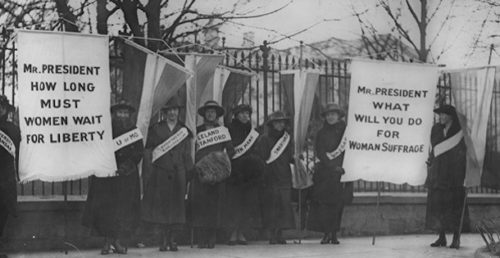
A decade before women gained the right to vote in the U.S., the women’s rights movement was working hard to claim incremental victories. Most progress came through quiet grit, relentless recruitment, and tireless organizing.
In 1909, there were many factions of the suffrage movement, all with varying perspectives. Some wanted only partial suffrage (victory at the municipal level), while others believed that they must fight for national suffrage. The National Women’s Party was often confrontational, organizing protests and marches. The National American Woman Suffrage Association focused on lobbying. Most work was done at the grass-roots level, with women holding luncheons, lectures, and letter-writing campaigns and traveling to state capitals to make their case.
An article by May K. Warwick from the June 12, 1909, issue of the Post applauded the headway the women’s rights movement had made. In the article, Warwick enumerates the many benefits of giving women the right to vote:
The suffragists assert that their movement has been related to that of higher education for women, and they point with pride to the seven thousand women doctors, three thousand ministers and one thousand lawyers in our country, to the three hundred occupations open to women and to the thousands of women’s organizations.
 The author notes that in the four states where women had the right to vote in 1909, regulations protecting women and children were enacted more quickly. This included laws that raised the age of consent, gave women the right to control their own income and property, and established free kindergarten.
The author notes that in the four states where women had the right to vote in 1909, regulations protecting women and children were enacted more quickly. This included laws that raised the age of consent, gave women the right to control their own income and property, and established free kindergarten.
Of course, things were still very different in 1909. While Warwick lobbied eloquently for the right to vote, she assured readers that women were not very interested in running for elected office.
The histories of the enfranchised states show that women have not rushed into office and that those they do hold are mainly educational and charitable. They will state that in all the parties women work in harmony with the men.
Warwick notes that if women were able to show equal pluck and determination after getting the right to vote as they did in petitioning for the right, they would prove a formidable force in American politics. Her article ends on an encouraging note:
The people of America have been stirred from their apathy and are thinking about suffrage. The race is indeed not always to the swift nor the battle to the strong; but some kind of worthy success always follows energy and courage.
It’s a good thing that the women had plenty of that energy and courage; the right to vote was still more than a decade away, and the road ahead would be a bumpy one. Protests continued throughout the 1910s. In 1913, the day before Woodrow Wilson’s inauguration, Alice Paul and Lucy Burns organized a suffrage parade. Opponents brought the protest to a near riot, and mounted police were called in.
Film of suffragettes marching from Newark, New Jersey to Washington, 1913.
In 1917, 200 suffragists were arrested and half were convicted following a protest at the White House. The harsh treatment of some of the women, including forced feeding in prison, bent public sympathies toward the movement.
After several false starts, the 19th amendment was eventually passed and ratified. The first presidential election in which women were permitted to vote in every state occurred in 1920. Despite this fact, many states took their sweet time ratifying the amendment. Mississippi was the last state to do so — in 1984.

Become a Saturday Evening Post member and enjoy unlimited access. Subscribe now



